Simple and easy to use! Wood-fired boilers for summer cottages are an excellent solution to the heating issue
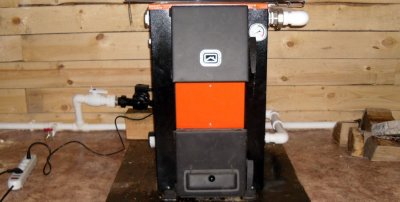
Wood boiler - a universal and inexpensive method of heating a country house.
Advantages: Firewood as a fuel is widely available, high degree of heating autonomy, wide range of technical solutions, easy installation and operation.
Content
Heating requirements for summer cottages
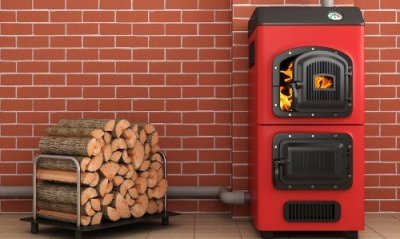
- Carrying out a one-time heating.
- High efficiency, the ability to quickly heat the room.
- Long-term work on one tab fuel.
- Desirable possibility of cooking.
- Autonomy from electricity.
- Fast and inexpensive installation.
Types of wood boilers for a country house
Depending on the goals, budget and type of summer house, different types of heating devices are purchased.
Liquid heating devices
Such a heating the device heats the heat transfer fluid, which transfers heat through radiators throughout the house. Reasons to buy a liquid boiler:
- The existing system of pipes and batteries.
- A large building with several floors or rooms.
- Increased requirements for the humidity of heated air.
- The need for slow but uniform heating of the room.
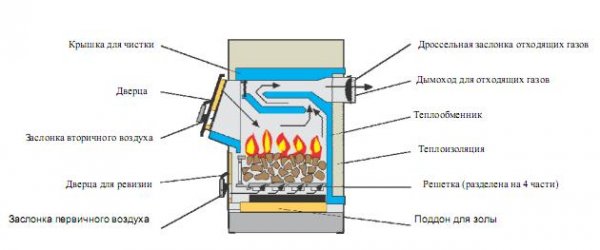
Photo 1. The structure of a wood-fired heating boiler. The arrows indicate the components of the device.
Boiler structure:
- Firebox. Serves for efficient burning of firewood. Various modifications allow for long burning, there are forced voracious fireboxes for quick heating.
- Heat exchanger. This element receives heat from the outgoing flue gases and transfers it to the heat carrier. There are plate heat exchangers, water jackets around the firebox, shelves and pipes passing through the chimney or firebox.
- Automation system. Combustion control is achieved by monitoring the incoming air. The control valve drive can be electrical or mechanical.
- Frame. It performs an aesthetic role, insulates the water jacket, firebox and heat exchanger.
- Chimney. Serves to remove combustion products. The boiler can be connected to an existing chimney or a new one can be built from sandwich pipes.
The design of a liquid boiler is aimed at heating the coolant. Manufacturers calculate the ratios and types of boiler elements to ensure uniform and complete combustion of wood and maximum heat removal.
Convection devices
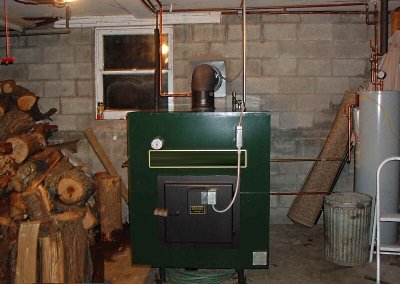
It is used for rapid heating of a building.. It is a metal firebox with an integrated heat exchanger. The basis of the equipment operation is heating the air and distributing it in the room.
There are many original and bold technical solutions that allow us to achieve both fast intense heating, and long burning with the release of even heat.
Popular designs include:
- Fireplace type firebox. Usually installed inside a brick jacket, which plays a decorative and heat-accumulating function. Heating occurs due to the heating of the surrounding air on the walls of the device.
- Buleryan and its derivatives. In such a system, the heat exchanger is built into the firebox, and pyrolysis gases are burned out. The room is heated by convective air movement through the heat exchanger channels.
- Long burning boilers with layered combustion. This is a recent development of heating on sawdust, small wood debris, small logs. The duration of operation is explained by the originality of the design of the firebox and the supply of air from above through a special air duct, which contributes to the long-term release of heat on one load.
An undoubted advantage: fast heating of the room. With forced air circulation, it warms up much faster than with liquid heating.
No need for antifreeze liquid coolant: antifreeze or special low-viscosity oils.
The system is obtained much simpler and more efficient.
If necessary, a heater equipped with a cooking stove, oven or bread makerThese useful functions make life at the dacha easier.
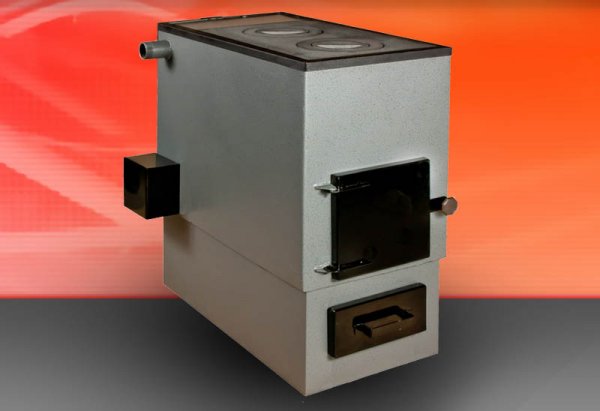
Photo 2. Heating wood boiler with a stove for cooking. Has two burners.
The disadvantage is considered to be the contact of air with the hot walls of the firebox. Burnt dust and overdried air require additional cleaning and moisturizing.
How to choose a boiler for a summer house
The retail chain offers various solutions for heating a small cottage or a house for seasonal heating. In order not to get confused in the variety of choices, it is necessary to pragmatically weigh all the initial parameters and define the tasks and the solution will be obvious.
- Plan the operating conditions of the radiator. If you live in a country house all year round, you will need a capital heating system; if you only stay there occasionally, air heating is better suited.
- Determine heat loss in a house. The higher this parameter, the more powerful the equipment required.
- Study the layout of the dacha. A one- or two-room house is heated by a fireplace or a potbelly stove. over 50 m2 requires central heating.
- To save space, narrow and tall houses are often built at summer cottages. You can heat the attic by placing hot air ducts throughout the house, or by designing a liquid heating system with a riser.
- Consider boiler maintenance. Firewood, ash and soot are a source of additional pollution; the door-to-firebox route should be short and not pass through living spaces.
How to install a wood burning heater
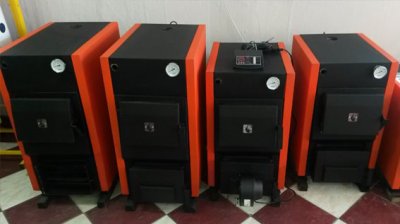
Before purchasing, be sure to It is worth thinking about the heating system layout and the placement of all its nodes.
The main requirement for installing a boiler is possibility of connecting or building a chimney, which is constructed in compliance with safety measures, passes through the ceilings, and the walls are reliably thermally insulated.
Convector boiler It is better to place them closer to the center of the house - the air ducts should be approximately the same length for uniform heating. Liquid boilers not so demanding in terms of layout: the boiler room is located outside the house with a separate entrance.
Attention! Ignoring the rules may cause a fire! Special non-combustible materials, passage boxes, and thickening of brickwork are used.
Identifying the need for an isolated room. Fireboxes of a battery heating system must be operated in a special utility room equipped with an exhaust hood, a window, and a chimney outlet.
DIY installation
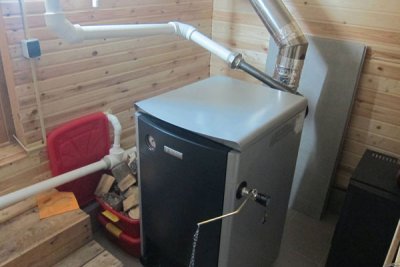
Installing a new boiler is not difficult. Most do not require a massive foundation, but lightweight plank floors are best reinforced with additional beams.
When installing an air heating boiler, safety precautions must be taken in advance - non-combustible apron made of tin or tiles, thermal insulation and shielding of flammable walls.
It is worth thinking about a place to store firewood.
Fix the boiler at the level, connect the chimney through the pipe systemThe joints must be sealed to prevent smoke from entering the room and air from being sucked in - this will reduce the efficiency of the chimney.
Connect the air heating pipes or liquid system pipes. Fill the system with water and conduct a test firing.
If the boiler operates normally, heats, does not smoke into the room, does not leak, all stages have been carried out correctly.
How to heat a solid fuel boiler
Mistake of newbies - heating with raw wood "from the axe", freshly cut.
Important! The maximum calorific value of firewood is achieved either by drying in an industrial chamber, or by storing for two years in ventilated stacks.
Maybe use of cardboard, paper, wood waste. Some fireboxes work well on sawdust and small wood waste, and if there is a lot of such fuel, it is better to purchase special devices.
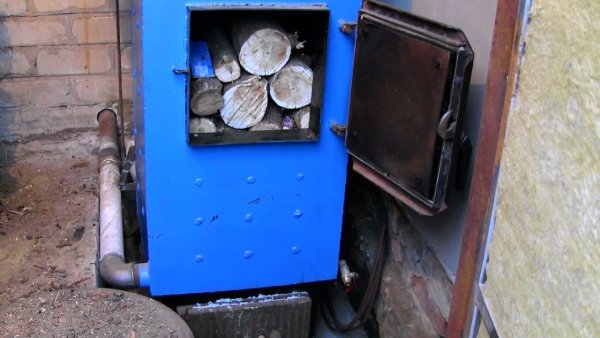
Photo 3. Loading firewood into the boiler. The fuel must be dry and fill the firebox of the heating device evenly.
It is forbidden to burn rubber, plastic, glued wood boards — the complex substances they contain pollute the atmosphere and lead to excessive soot formation. Soot deposits reduce traction and, if ignited, can cause a fire.
Among modern types of fuel, a special place is occupied by pressed pellets from sawdust and plant waste, and also fuel briquettes made from wood chips or peatThis is a high-calorific fuel, which allows for automated loading and long-term combustion.
Useful video
Watch the video to learn how to choose the right wood-fired heating boiler.
Is it worth heating with wood?
The following solutions are suitable for a summer house: heating with electricity, fuel oil or used motor oil, gas in cylinders, using solar heating. However, heating with wood remains one of the leaders.
Advantages:
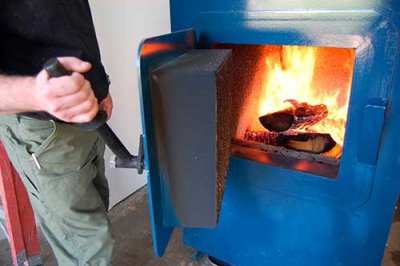
- Cheap and accessible fuel.
- Simplicity and low cost of equipment.
- A huge range of technical solutions for any task.
- Aesthetic component: some types of boilers have a transparent door for observing the live flame.
Flaws:
- The need for labor-intensive fuel preparation, storage and drying.
- Heating with solid fuel requires at least one batch of firewood per day; if the owners are temporarily away, the house will be cold.
These shortcomings are solved by installing alternative heating systems., purchasing ready-made fuel.







Comments
A wood-fired boiler for a summer house is a source of valuable fertilizer - ash, which serves as a top dressing and protects against a number of pests, including rodents.